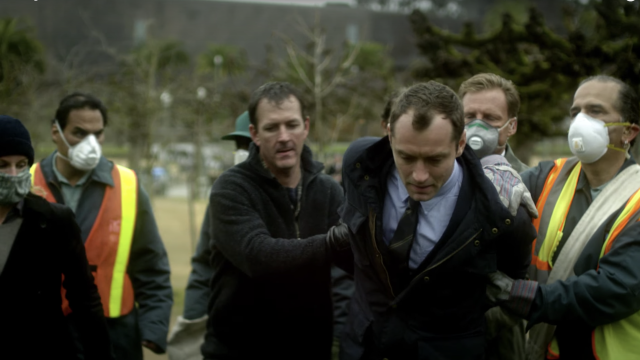Ever since I saw Contagion earlier this year, I haven’t been able to stop thinking about the guy hocking “forsythia,” that universe’s counterpart to hydroxychloroquine. In the 2011 movie, pandemic misinformation is personified in one blogger who claims that the CDC is suppressing the fake cure. People stampede and loot a pharmacy to get it.
Contagion was well researched, with scientists and doctors consulted to shape how it depicted the development of, and response to, a deadly pandemic. Watching it in February, I appreciated the way it educated viewers about contact tracing, fomites, the fact that vaccine production takes time, and even epidemiological concepts like R0.
At the time, I thought the fictional pandemic was a lot more dramatic than ours would ever be. Americans wearing masks? Schools and stores shut down for months at a time? Yeah, right. But those predictions came true. (The 25% mortality rate, fortunately, did not.)
But the writers didn’t go far enough in imagining the web of disinformation that results from a pandemic. They needed to constrain their cast of characters and keep plot lines simple, but one thing we’ve learned in this pandemic is that people will believe what they want, and alter their understanding of everything else to match. We also learned that authority figures, including world leaders, are not immune to conspiracy theories’ thrall.
As John Oliver pointed out, people want a big scary explanation for a big scary life-altering phenomenon. And so there are people connecting the dots in various ways, many of them incompatible with others. For example, in real life there are people saying the virus doesn’t exist or is completely harmless, while others say it is a foreign plot intended to kill Americans. Some say masks are useless and that the virus is nothing to fear; others say masks make us sick and police will soon drag us out of our homes to forcibly administer evil microchips and population-control devices in the guise of vaccines. (None of these things, of course, are true.)
At first I thought the most unrealistic part of the movie was when the forsythia-pushing scammer is arrested for fraud. Now I’m thinking the most unrealistic part is that he operated in a world where everyone agreed that the virus was real, that it was bad, and that stopping it would be a good thing.
The stories we tell matter. Sonia Shah wrote this summer that the stories we tell ourselves about pandemics shape how we react to them in real life. When antibiotics and vaccines were first discovered, a narrative emerged that all you need to beat a disease is a commodity that can be bought and sold. This turned out not to be true of very many diseases, of course, but the idea persists.
As a result, Shah writes, “the biomedical establishment focuses most of its attention and resources on finding magic bullet cures for contagion rather than addressing the underlying drivers.” The movie focused on the fake cure and the real vaccine. We are doing something similar with our virus, making a big deal out of hydroxychloroquine or this or that vaccine study, when societal fixes like providing universal income and health insurance, or releasing people from overcrowded prisons, could potentially do a lot more to stem its spread.
Nor did the movie begin to scratch the surface of how politicised a virus could be. There were anti-vaxxers in 2011, and the movie hints that the scammer could do unthinkable damage if he were to talk people out of getting the vaccine. In 2020, not only do anti-vaxxers have a bigger reach than ever, many of them have tied their views on vaccines to their views on masks, lockdowns, politics, and more.
Another thing that stands out in hindsight is the curiosity of both researchers and the public at the beginning to find certain pieces of information. Where is “ground zero,” the movie’s epidemiologists asked? And how quickly can we figure out the R0?
In the movie, as well as in real life, neither answer mattered very much. The virus’s basic reproduction number, R0, tells us a little bit about the speed with which it spreads, but it’s not a missing piece needed to formulate a response. It’s been far more important to know how the virus is transmitted — aerosols may be more important than surface contamination, for example.
And we still don’t know where the coronavirus came from. Early reports clustered around a seafood market in Wuhan, but that’s probably not where it started. In Contagion, the characters never figure it out. Instead, we get an omniscient flashback to peek into its origin just before the closing credits.
Watching Contagion in late 2020, I found myself wishing this pandemic could have happened in a world where a vaccine could be safely developed in a matter of months, where the government is basically trying to do the right thing, and where misinformation was just one guy with a blog.

Leave a Reply
You must be logged in to post a comment.